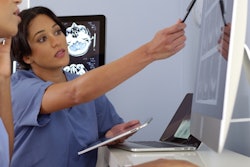
As the COVID-19 pandemic begins to wane, radiologists can begin to consider what will be the "new normal" going forward, according to a talk given May 18 at the International Society for Magnetic Resonance in Medicine (ISMRM) and Society for MR Radiographers & Technologists (SMRT) virtual annual meeting.
Past experiences with severe acute respiratory syndrome (SARS) and the current pandemic offer key lessons that can be used to prepare for the next epidemic, said presenter Dr. Bien Soo Tan of Singapore General Hospital.
"There's light at the end of the tunnel, with better knowledge of how to treat the disease, how to reduce transmission, and the advent of mass vaccination," he said.
Singapore clinicians learned "bitter lessons" from the 2003 SARS outbreak, Tan said. Hospitals there took action in the following ways:
- Prioritized infection control and prevention at system and individual levels
- Incorporated this infection control into daily operational workflows and adjusted department infrastructure to facilitate this
- Separated inpatient and outpatient imaging facilities
- Crafted emergency plans that included infectious disease outbreak response
These actions make up the backbone of a pandemic response, but in light of COVID-19, it's clear more is needed, according to Tan.
"We need to understand the future perspectives of our patients and our workforce," he wrote in his presentation summary. "Patients will expect the highest level of infection prevention practices ... [and] healthcare institutions will need to design facilities that can pivot in function during disease outbreaks."
Tan offered a number of practical actions departments can take, such as the following:
- A "just-in-time" imaging protocol to reduce physical contact between patients and staff
- Putting artificial intelligence (AI) technology to use to manage patients' experience in the radiology department
- Moving inpatient x-ray and ultrasound to portable platforms
He also described relatively simple innovations that can protect patients and staff from infection, such as a polycarbonate booth that separates the patient from x-ray equipment and the radiographer, thus reducing the need for personal protective equipment (PPE) and time-consuming cleaning.
Going forward, imaging services will become increasingly "phygital," Tan said, as robotics are incorporated more and more into the care continuum.
"We already use robots for cleaning, but we can also use them to help patients find their way around [the radiology department]," he said.
Future healthcare infrastructure planning should include making facilities multifunctional, according to Tan: Singapore General used part of its parking garage as an overflow facility for COVID-19 screening when the emergency department was overwhelmed.
But one of the most important things to keep in mind in times of crisis is healthcare staff, Tan noted.
"This pandemic has shown that our workforce is our most precious resource," he said.
Tan listed three ways to ensure staff can be both functional and healthy:
- Listen: Collaborate and communicate via multiple channels and platforms, depending on the purpose. Understand generational communication preferences.
- Protect: Maintain a physically safe workplace, ensure adequate supply of PPE, develop robust workflow protocols, and ensure sustainable work hours with adequate rest.
- Support: Show appreciation to every staff member and offer care to those who need psychological support.
"Radiology must seize the opportunities presented by the COVID-19 crisis," Tan concluded.




.fFmgij6Hin.png?auto=compress%2Cformat&fit=crop&h=100&q=70&w=100)




.fFmgij6Hin.png?auto=compress%2Cformat&fit=crop&h=167&q=70&w=250)











